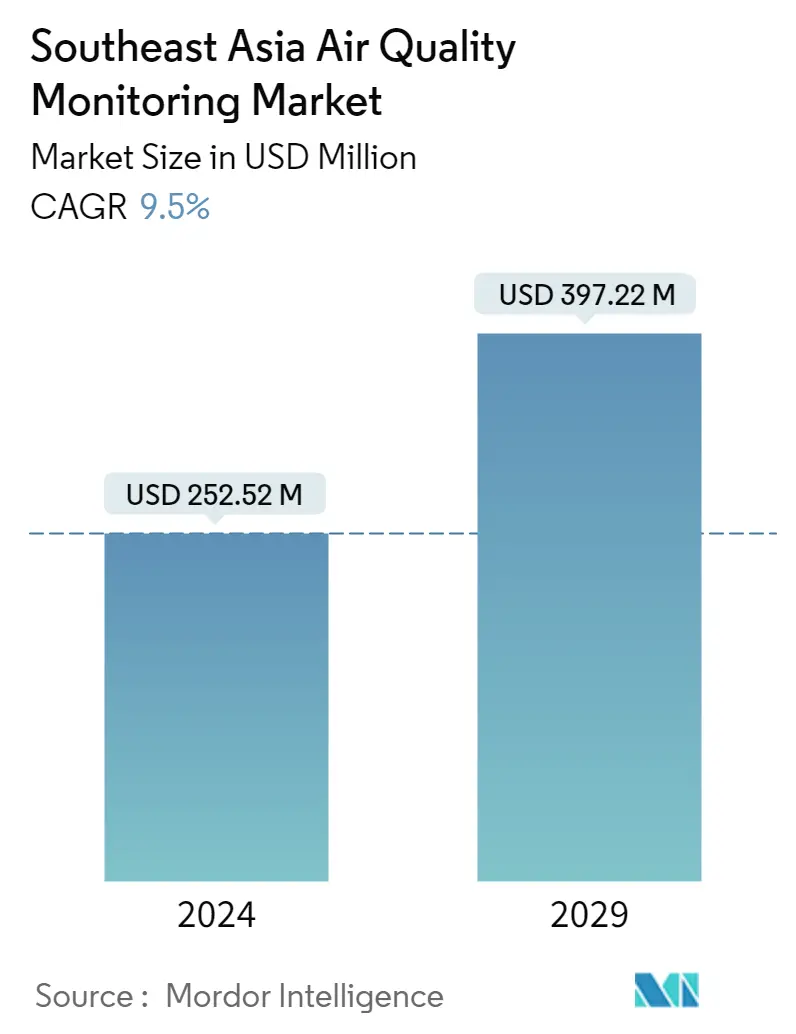Market Size of Southeast Asia Air Quality Monitoring Industry

| Study Period | 2019 - 2029 |
| Base Year For Estimation | 2023 |
| Market Size (2024) | USD 252.52 Million |
| Market Size (2029) | USD 397.22 Million |
| CAGR (2024 - 2029) | 9.50 % |
| Market Concentration | Low |
Major Players
*Disclaimer: Major Players sorted in no particular order |
Southeast Asia Air Quality Monitoring Market Analysis
The Southeast Asia Air Quality Monitoring Market size is estimated at USD 252.52 million in 2024, and is expected to reach USD 397.22 million by 2029, growing at a CAGR of 9.5% during the forecast period (2024-2029).
- Over the medium period, increasing industrialization and urbanization are leading to a deterioration in air quality, driving the demand for air quality monitoring and purification, especially in developing countries.
- On the other hand, the penetration of renewable and greener energy to support the government's net zero carbon emission policy is expected to hinder the market in the forecast period.
- The technological advancements in air quality monitoring systems create enormous opportunities for the techno-development of devices and their applications. For instance, the recent IoT-based equipment, which is more interactive in its functioning and uses new technologies for communicating and delivering data, is in vogue these days. They are termed the Next Generation Air Quality Monitoring Systems, becoming the research subject for many R&D professionals in the area.
- Indonesia is expected to dominate the Southeast Asia air quality monitoring market as the country holds the majority share in primary energy consumption.
Southeast Asia Air Quality Monitoring Industry Segmentation
Air quality monitoring includes monitoring the quantity and types of specific contaminants in the ambient and outside air allowing for the systematic, long-term assessment of pollutant levels.
The Southeast Asia Air Quality Monitoring Market is segmented by Product Type (Indoor Monitor and Outdoor Monitor), Sampling Method (Continuous, Manual, and Intermittent), Pollutant Type (Chemical Pollutants, Physical Pollutants, and Biological Pollutants), End User (Residential and Commercial, Power Generation, Petrochemicals, and Other End Users), and Geography ( Indonesia, Myanmar, Vietnam, and rest of Southeast Asia ). The report offers the market size and forecasts in revenue (USD Billion) for all the above segments. For each segment, the market sizing and forecasts have been done on the revenue (USD).
| Product Type | |
| Indoor Monitor | |
| Outdoor Monitor |
| Sampling Method | |
| Continuous | |
| Manual | |
| Intermittent |
| Pollutant Type | |
| Chemical Pollutants | |
| Physical Pollutants | |
| Biological Pollutants |
| End User | |
| Residential and Commercial | |
| Power Generation | |
| Petrochemicals | |
| Other End Users |
| Geography | |
| Indonesia | |
| Myanmar | |
| Vietnam | |
| Rest of Southeast Asia |
Southeast Asia Air Quality Monitoring Market Size Summary
The Southeast Asia Air Quality Monitoring Market is poised for significant growth over the forecast period, driven by increasing industrialization and urbanization, which are contributing to deteriorating air quality in the region. This trend is particularly pronounced in developing countries, where the demand for air quality monitoring and purification systems is on the rise. Technological advancements, such as IoT-based equipment, are creating substantial opportunities for the development of next-generation air quality monitoring systems. These innovations are becoming focal points for research and development, offering more interactive and efficient data communication and delivery. Despite the positive growth prospects, the market faces challenges from the penetration of renewable energy sources, which align with government policies aimed at achieving net-zero carbon emissions.
Indonesia is expected to dominate the market due to its significant share in primary energy consumption and its status as a major producer and consumer of oil and gas in Southeast Asia. The country's industrialization has led to increased chemical pollutants, driving the need for robust air quality monitoring solutions. Outdoor air quality monitoring systems are particularly in demand, as they track pollution from various external sources, including transportation and construction activities. The market is characterized by fragmentation, with key players such as Siemens AG, Thermo Fisher Scientific Inc., and Honeywell International Inc. actively participating. Initiatives like the AQUAMS Project in Malaysia and the development of mobile applications in Vietnam highlight ongoing efforts to enhance air quality monitoring capabilities in the region.
Southeast Asia Air Quality Monitoring Market Market Size - Table of Contents
-
1. MARKET OVERVIEW
-
1.1 Introduction
-
1.2 Market Size and Demand Forecast in USD, till 2028
-
1.3 Recent Trends and Developments
-
1.4 Government Policies and Regulations
-
1.5 Market Dynamics
-
1.5.1 Drivers
-
1.5.1.1 Increasing Industrialization and Urbanization are leading to a Deterioration in Air Quality
-
-
1.5.2 Restraints
-
1.5.2.1 Penetration of Renewable and Greener Energy
-
-
-
1.6 Supply Chain Analysis
-
1.7 Porter's Five Forces Analysis
-
1.7.1 Bargaining Power of Suppliers
-
1.7.2 Bargaining Power of Consumers
-
1.7.3 Threat of New Entrants
-
1.7.4 Threat of Substitute Products and Services
-
1.7.5 Intensity of Competitive Rivalry
-
-
-
2. MARKET SEGMENTATION
-
2.1 Product Type
-
2.1.1 Indoor Monitor
-
2.1.2 Outdoor Monitor
-
-
2.2 Sampling Method
-
2.2.1 Continuous
-
2.2.2 Manual
-
2.2.3 Intermittent
-
-
2.3 Pollutant Type
-
2.3.1 Chemical Pollutants
-
2.3.2 Physical Pollutants
-
2.3.3 Biological Pollutants
-
-
2.4 End User
-
2.4.1 Residential and Commercial
-
2.4.2 Power Generation
-
2.4.3 Petrochemicals
-
2.4.4 Other End Users
-
-
2.5 Geography
-
2.5.1 Indonesia
-
2.5.2 Myanmar
-
2.5.3 Vietnam
-
2.5.4 Rest of Southeast Asia
-
2.5.5
-
-
Southeast Asia Air Quality Monitoring Market Market Size FAQs
How big is the Southeast Asia Air Quality Monitoring Market?
The Southeast Asia Air Quality Monitoring Market size is expected to reach USD 252.52 million in 2024 and grow at a CAGR of 9.5% to reach USD 397.22 million by 2029.
What is the current Southeast Asia Air Quality Monitoring Market size?
In 2024, the Southeast Asia Air Quality Monitoring Market size is expected to reach USD 252.52 million.

